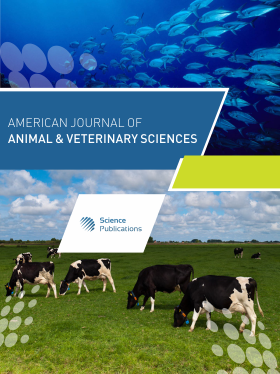EFFECT OF PUERPERAL METRITIS ON HOLSTEIN COWS PRODUCTIVE, REPRODUCTIVE VARIABLES AND CULLING RATES
- 1 Sadat City University, Egypt
- 2 Tuskegee University, United States
Abstract
The objective of the study was to determine the effect of puerperal metritis prevalence in high yielding Holstein cows on productive (305 days, actual milk yields), reproductive (days to first estrus, days open and services per conception) variables and culling rates. Throughout the study, 2885 dairy records were collected from high yielding private Holstein dairy farm (average milk yield was up to 9000 kg) for 3 successive lactation seasons. Dairy cows were classified according to their uterine affection into two groups, healthy and those with puerperal metritis. Dairy cows which affected with puerperal metritis were diagnosed during the first 3 weeks of lactation. Metritic cows were diagnosed and treated at the discretion of the herd veterinarian. Affected dairy cows were grouped into four groups according to time of the puerperal metritis attack during the first 21 Days In Milk (DIM) as (<5; 5-10; 10-15 and >15 DIM, respectively). Moreover, the dairy females were grouped into 3 groups according to frequency of puerperal metritis of once, twice and triple, respectively. Dairy cows were also grouped according to their calving season (winter, spring, summer and fall calving seasons). Productive, reproductive variables and culling due to puerperal metritis were detected from the on-farm record system (DairyComp305). Results of this study revealed that, puerperal metritis had bad effects on high yielding cows productive and reproductive variables, that decreased the 305 milk yield, increased days to first estrus, days open and number of services per conception. Moreover, the occurrence of puerperal metritis increased during the warm months of spring and summer seasons. Also, the occurrence of such disease was increased during the first 10 days of postpartum as (89.98%) of the affected cases occurred within this period. Care must be directed to dairy cows which had a history of puerperal metritis as these cases had a greater tendency for recurrence. Also, the re- attacked cows with puerperal metritis had a great chance to be culled from the dairy herds, as they reached to (53.33% and 100%) for the second and third attack, respectively.
DOI: https://doi.org/10.3844/ajavsp.2014.162.169

- 3,667 Views
- 3,621 Downloads
- 10 Citations
Download
Keywords
- Puerperal Metritis
- Dairy Cows
- High Yielding Holstein
- Culling Rate
- Milk Yield
- Reproduction
